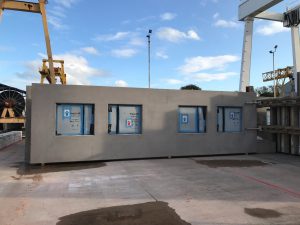At Kier, digital tools and offsite manufacturing are fundamental to successfully delivering value for our for clients throughout the lifecycle of the project. BIM and Modern Methods of Construction go hand-in-hand with the Government’s aims of reducing costs through increased productivity and advanced data management.

Nowhere is the success of this approach more evident than our new build prison at Wellingborough for the Ministry of Justice. This vast £253m project is implementing a DfMA approach, incorporating over 60,000 repeatable, standardised components, assemblies and sub-assemblies across the site. We are trialling cutting-edge technologies, fully engaging with our team, supply chain, partners and client to provide tangible benefits in terms of cost, programme, predictability, quality, safety, productivity and end-user experience. BIM and digital is front and centre, helping us improve as we take learnings from this flagship digital scheme and apply its successes to other projects.

The new prison development at Wellingborough will create a safe, secure and decent environment for both staff and offenders, aiding rehabilitation and supporting the Ministry of Justice’s (MoJ) broader sustainability commitments. The new prison will create 1,680 places and is expected to open in 2021. The design developed for the facility is conducive to rehabilitation. Buildings feature windows with no bars and each landing can be split into three, with each spur holding just 20 men. There is an association space for residents to use and the visitors’ hall has been designed to be open and light to instil a sense of normality for those visiting.

A core feature of the programme is to optimise how the MoJ’s assets are designed, procured, delivered and operated, through a Design for Manufacture and Assembly (DfMA) or ‘platform’ approach. As project integrator, Kier is driving a manufacturing mindset for Wellingborough by bringing together a diverse team to deliver this component-led approach. The scheme incorporates repeatable, standardised components and assemblies across the thirteen buildings on site. Circa 80% of the design has been standardised, leaving just 20% as site-specific design. This means that the component assemblies designed for Wellingborough can and will be used on subsequent MoJ prison projects, leveraging economies of scale for the programme.

Nine of the buildings at Wellingborough have been designed to make extensive use of precast concrete construction, incorporating 15,183 precast panels plus more than 60,000 sub-components. The scheme is utilising three separate precast suppliers; Bison Precast, FP McCann and Banagher in a total of six different factories across the UK. The immense scope of work demands very close collaboration between all parties, and the precast sector has shown its maturity to work together to deliver a project of this scale; setting itself at the forefront of true pan-sector collaboration.
The scale of the build has facilitated significant investment within our supply chain and we are using Wellingborough at every opportunity as a platform to educate, train and inspire industry professionals to fully appreciate all aspects of digital and Design for Manufacture and Assembly at all stages in the lifecycle of the project.

Key achievements
- Extensive supply chain integration and shared learning
- Platform ‘kit-of-parts’ approach with application for future prison projects
- Digital and quality embedded throughout the lifecycle of the project

